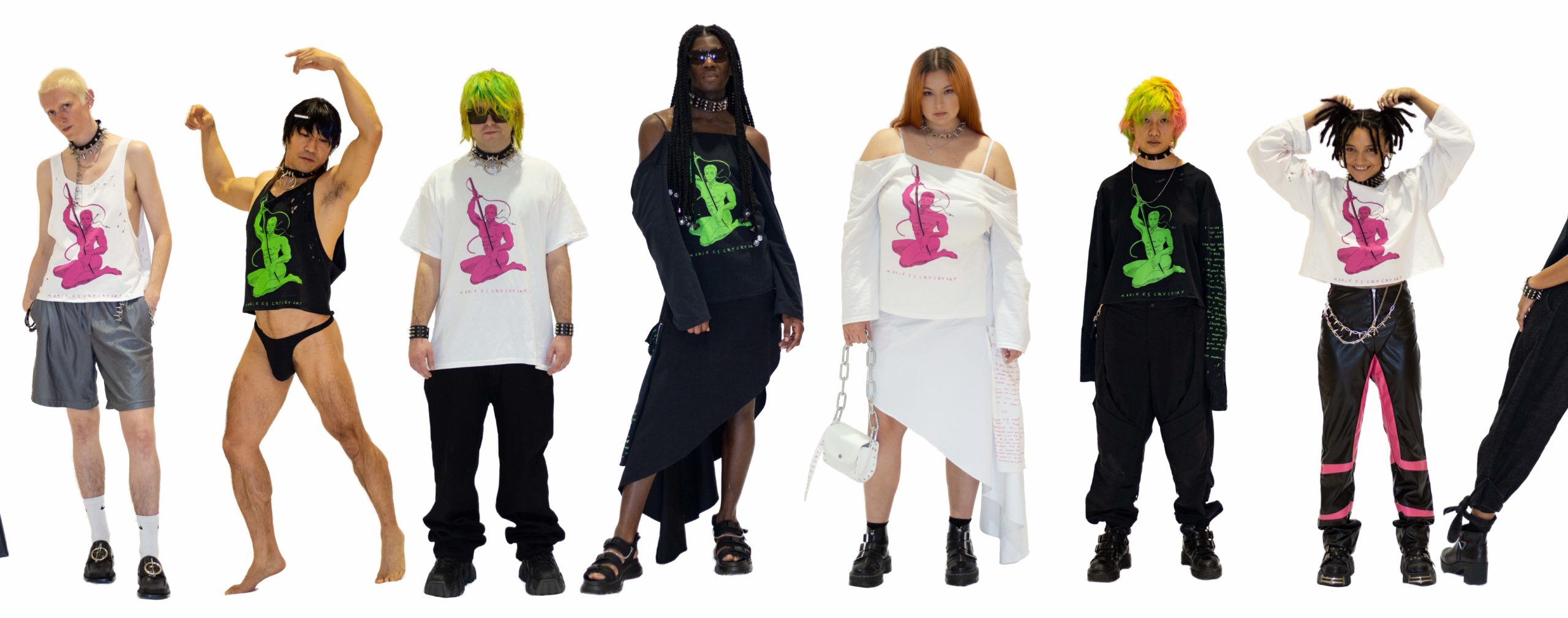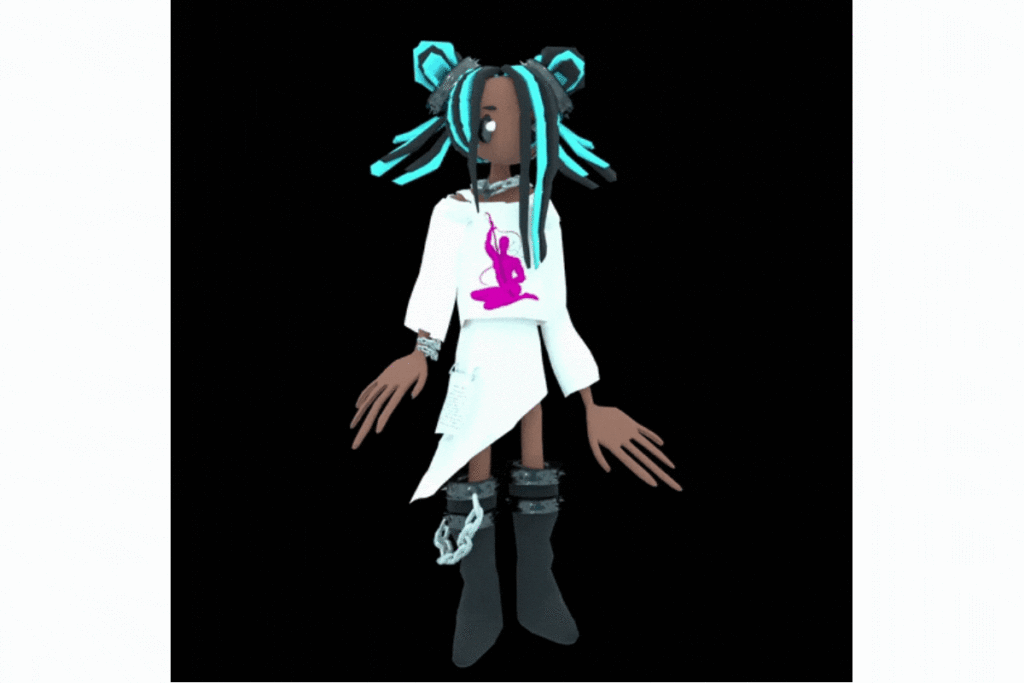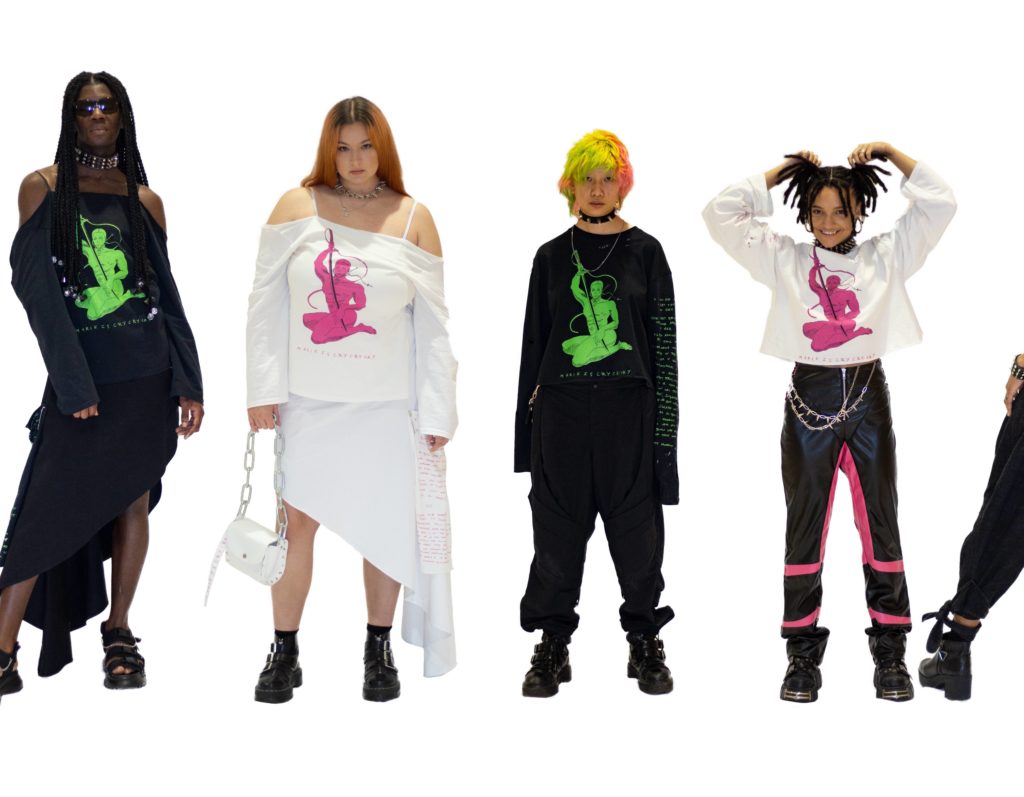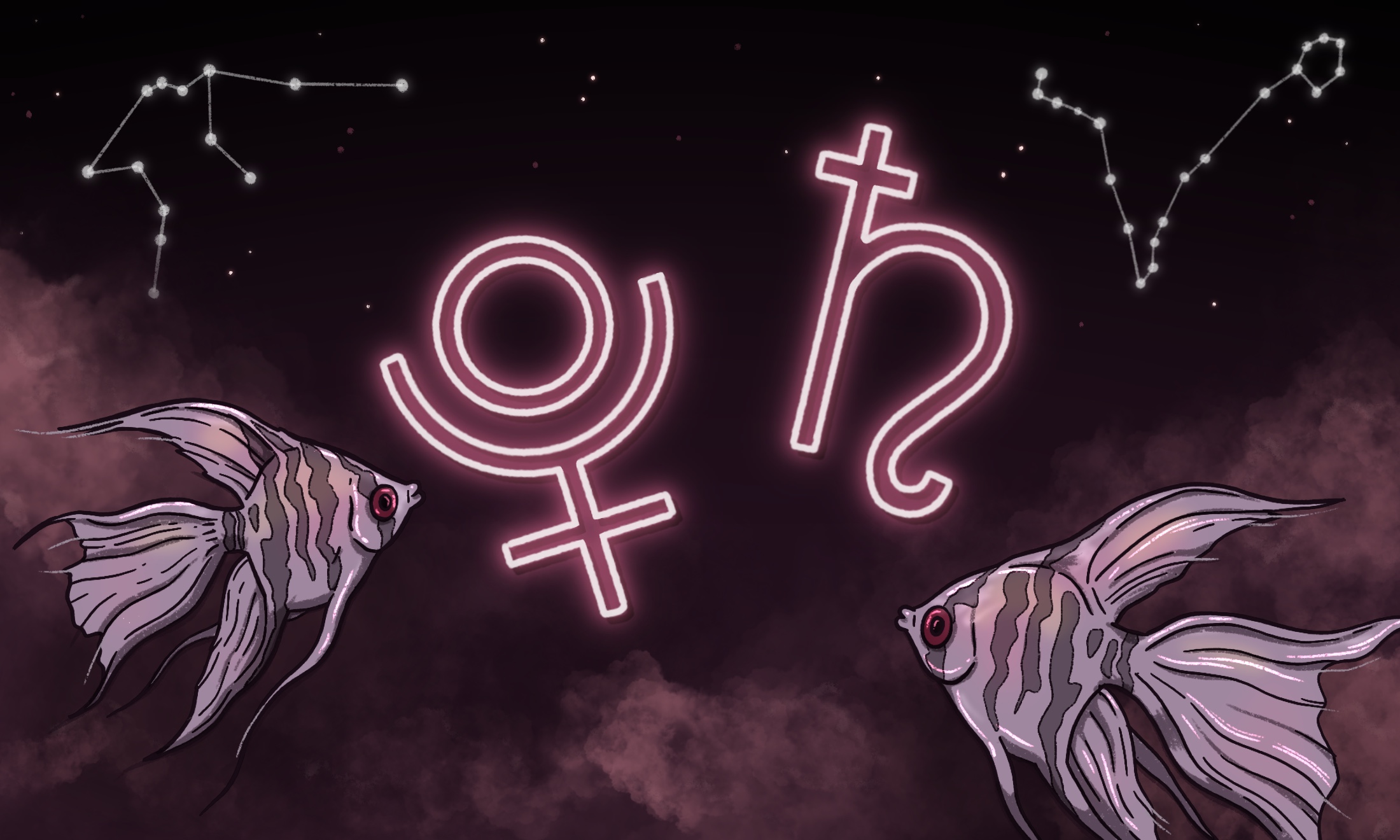
‘I’m expanding beyond those attempts to box us’, Marikiscrycrycry is reimagining performance art through alt fashion
In the year of cancelled live art, Malik Nashad Sharpe is bringing cyber-punk aesthetics to their debut collection.
Travis Alabanza
25 Nov 2020
“I’m not going to wait for theatre’s and galleries to open, making things is my passion. It’s the thing I know how to do,” Malik says to me, without hesitation.
I am joining Malik on a slightly lagged Bristol to London zoom call, as is the 2020 normality, to raise a toast and celebrate the launch of their debut fashion collection MISS ME ERODE. It’s their first mini-collection directed by Malik and made by designer Sam Ray. A collection of DIY aesthetic cyberpunk pieces that within 24 hours of its release, already sold out of multiple items.
Some interviewers would start with a pronoun check, yet I am far more interested in knowing if I should refer to them as the name saved in my phone book, or their artist alias and Instagram handle, Marikiscrycrycry. They shrug, in a way that makes me aware I am missing or oversimplifying the point, explaining that rather than being a moniker, Marikiscrycrycry is also an artistic body of work. A project for their art to exist within.

“I made the alias as a vessel. I was tired of being punished for things I was saying, and I needed a name to be able to hold what I was trying to communicate,” Malik mentions coming up with the alias in a basement performance space in New York, where they were resident before moving to the UK. “I created the alias in the midst of huge racial awakenings in the states”. I blink. Reminding myself that unfortunately, this is a line that could mean any time periods we have been in.
“It’s a level of protection, but also a more exciting way to communicate my politics and how I feel. I am an artist, not an activist, not a spokesperson, I am an artist.” Malik describes. It’s almost like a shield, something to block or protect them from the natural aggressions that institutions, audiences and general public throw at Black artists. I think about this a lot as they say this. I wonder about what sacrifices we as Black trans artists have to make to be seen, and what we lose along the way through those sacrifices. I see Malik’s grapple to hold onto their politics, one that talks of abolition, gender freedom, Black liberation, as a way to hold onto their autonomy.
Malik, like me, is an artist who primarily works within live art and performance, that often transcends the barriers of both form and location. I’ve seen Malik’s invigorating work in the Tate, in clubs like the Royal Vauxhall Tavern and posh dance schools that I could not remember the names of. All live work is, in its definition, live, yet watching Malik’s work feels so inseparable from the pulsing experience of being in the flesh. It feels like a trap party where only Black emos are invited. Or a lyrical dance transported into a music video.
Malik’s latest work, He’s Dead sold out Yard Theatre run last year. It was a choreographic group piece which explored Tupac’s legacy in relation to his depression and linked it to Malik’s own exploration of self and mental health. I could see the sweat dripping from the dancers, feel the overwhelming bass of the music and my eyes constantly bouncing between mesmerising shapes and a gothic punk aesthetic particular to Malik’s work. And so, I’m wondering if they had to spend much of 2020 wrestling with what it means to be a live artist when so many of the venues holding our work are temporarily closed.
“So often fashion can feel so distant to the buyer, yet suddenly through the lens of performance and artist, I feel almost as if I am getting a ticket to their show”
“This year was not supposed to be spent in one place. I was in the mind frame that I would be touring four different works across the world for all of 2020,” Malik says. It’s a painfully relatable statement. Yet it is with this pause, and forced feeling of being in postponement, that MISS ME ERODE was conceived. MISS ME ERODE, a combination of a Dir en Grey song and the colloquial phrase, “miss me with that ____” is another example of Marikiscrycrycry’s refusal to be tied down to artistic form.
“I have to always be in the mode of making. So, I spent time cracking open my practice. What can I find that is new and that I have not done, that I can only do with this space from touring.” For some that was learning to make sourdough, for others that was becoming Tik Tok fanatics and for Malik that was delving into the world of fashion collection.

“In performance, people connect to you. How can I make my audience connect with my choreography and themes yet this time through clothing?”And it’s true, even the way in which MISS ME ERODE was advertised and realised has all the distinguishing features of a Marikiscrycrycry/Malik Nashad Sharpe performance. From the clear influence of 00s emo aesthetic mixed with canonically Black internet references, even if I was not looking at the promotion through Instagram – I would know who had made it.
Just one click on their website and it’s not traditional models wearing the clothes, that would instantly create a comparison (and no doubt dysphoria for me) when looking to buy. Instead, there are genderless, cyber animations of cute versions of Malik wearing the collection, like a cool video game I would have saved up to play. The same playfulness, aesthetic and influences many are so used to seeing in a Marikiscrycrycry performance are here on the screen.
“There is a way for us to maintain connection, do something together, yet through the intentions of design and not live performance. How do I keep the performance alive but in fashion?” The writing on the back of my Marikiscrycrycry dress, some legible some not, which Malik notes in excerpts from their poetry called ‘Good Things Come To Those With A Bad Attitude’ which will be published in the Capilano review in 2021.
The range is also modelled by a collection of people who make up a vast range of queer and PoC artists in London, from Ebun Sodipo to Rene Matic. The collection feels like a hybrid of things, like the opposite of being off the rack. So often fashion can feel so distant to the buyer, yet suddenly through the lens of performance and artist, I feel almost as if I am getting a ticket to their show the moment I put on the black, long-sleeved, grunge-styled dress. As I match the black long-sleeved dress, adorned in a logo that places Malik in a medusa like logo, with a fishnet top underneath.
I now wonder if the aim is to not just feel like you are at one of Malik’s shows, but maybe like you are performing within it.

“There are so many sick clothes there, but that itself doesn’t sell a collection.” And then for me, it clicks. I get excited all over again as a performer. That may be in the year of cancelled live work, ever-changing government guidelines and a collective yearning for performance – that it is actually all about channelling what you (and in turn your audience) miss, into something they can have.
I’m not sure if Malik’s grunge, cyber-esque, Black punk aesthetic is necessarily something I would buy, but as I click purchase on the dress and save up to buy the cute leather bag – I realise that is not the point. I am, in fact, purchasing to experience Marikiscrycrycry again. I want to wear the dress because it reminds me of their shows, and I cannot see their shows – so I want to be seen in this dress. Suddenly, the “MISS ME” in MISS ME ERODE, feels like a love letter to the audience of their performances. Like an elevated sense of merchandise, pushing boundaries of what ‘buying a t-shirt after the show’ could mean.
I stare at the animated version of Marikiscrycrycry on their website, and I ask Malik how they would describe their alias? “A cry baby bitch!” they reply. I probe further, looking for something more suitable to write. And although I am given articulate phrases about Black punk, DIY culture, a resistance to institutional pigeonholing, and an alias that captures a Black trans aesthetic – their first answer was the most apt in the description. Responding “a cry baby bitch!” with a cheeky nod and a wink feels like the exact “do it on my own terms” energy Malik has encapsulated in their work, one that refuses to be boxed into neat markers and descriptors that so many institution’s force onto artists of certain identities.
I go to ask a question about genderless clothing, how Malik has made a genderless collection, and what that means – but as if spotting where the interview could go – Malik reminds me to push myself somewhere more interesting.
“Of course I could be more savvy to sell myself. But transness, Blackness, me – is not about being in a box.” I nod, thinking of all the things I have lost by allowing boxes to be placed on me. “If it’s all about our identity, then how can it be about our work? I do not want to lose my expansiveness if it comes at the cost of selling something. I could go on and on about the gender, or lack of gender, in this clothing – but that’s so obvious – why don’t we look at the work? I’m expanding beyond those attempts to box us”.
“Institutions, the art world, whiteness, it only ever wants us if we can be neat and tidy – but my art is about rejecting all of that obsession”
“People want the most digestible thing, no contradictions, no simultaneity, but I am not going to give them that,” they tell me. It is this part of the conversation where I feel not only the most challenged of my own artistic choices but also the clearest of Malik’s. It seems whether they are performing in basement bars in New York, resident artist in Tate galleries or even working within senior leadership at Dance4 institution via a joint role with fellow live artist Zinzi Minott – Malik’s practice and work is about claiming autonomy, and deciding what to do on their terms.
“Institutions, the art world, whiteness, it only ever wants us if we can be neat and tidy – but my art is about rejecting all of that obsession. People ask my pronouns or my identity and I’m like, urgh, next, surely I am expanding beyond that. I am working for the freedom of all Black people, not to be put in a box”.
Malik pauses after this. Suddenly, anything I may say about genderless fashion, or a question on Harry Styles in Vogue, feels like an insult to the ways in which this work and artist exists outside of that. Like a reminder to the ways Black gender non conforming artists have consistently been setting their own form, influencing their own trends and refusing constraints.
MISS ME ERODE is a collection that did not wait for the world to re-open or the theatre foyer to exist. Similarly, it feels clear that Malik themselves is an artist that refuses to wait. They did not wait for a fashion degree or course to create their collection. They did not wait for UK dance to show even an ounce of being ready or welcoming to Black trans artists, instead they decide to do it themselves with their own language, and let the rest of the art world catch up to feeling – as those within the growing Marikiscrycrycry cult, feel – like incredibly lucky guests.








